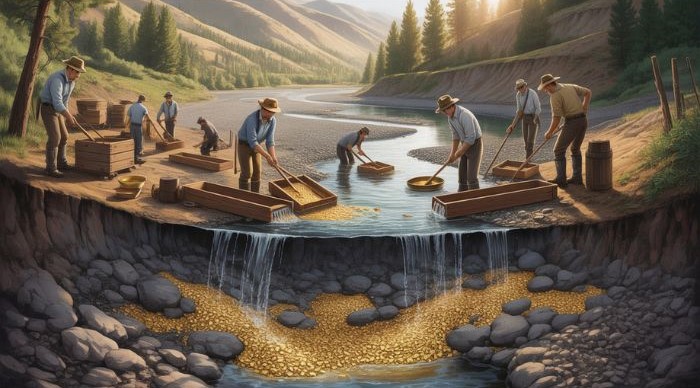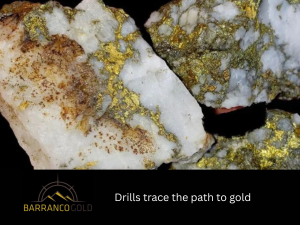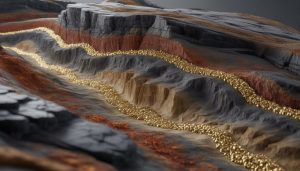On This Page
Table of Contents
Placer mining has stood the test of time, evolving from a simple technique used by early prospectors to a modern practice still relevant in today’s mining industry. While the method has significantly changed with advances in technology and equipment, its core principles remain the same: placer gold mining involves extracting gold from alluvial deposits using natural forces like water to separate heavier materials from lighter ones.
What is Placer Mining?
At its core, placer mining is a method used to extract valuable minerals, primarily gold, that have been deposited by natural forces such as water, wind, or ice. These deposits are typically found in riverbeds, streambeds, and other alluvial environments where the minerals have been carried from their original source by the movement of water.
Placer Mining Definition
To define placer mining, it is the process of extracting gold or other valuable minerals from loose material, which could include sand, gravel, and dirt, usually deposited in riverbeds, lakes, or other alluvial environments. Placer mining makes use of the fact that gold is heavier than most other substances, causing it to settle at the bottom of streams and rivers, making it easier to separate from the surrounding debris.
How Does Placer Gold Mining Work?
Placer gold mining is one of the oldest and simplest methods of extracting gold from alluvial deposits. The process is based on the natural properties of gold, which is much denser than most other materials. This density allows gold to settle at the bottom of riverbeds, stream beds, or other watercourses over time, making it easier to recover using various mining techniques.
What Was Placer Mining?
The method of placer mining was widely used in the 19th and early 20th centuries, particularly during the gold rushes. These gold rushes, including the famous Gold Rush, saw a massive influx of miners who flocked to rich riverbeds to extract gold from placer deposits. Miners would use rudimentary tools to sift through the riverbanks, recover gold, and then move on to the next location once the area was worked out.
The Basic Process of Placer Gold Mining
The process of placer mining is relatively simple but effective. Miners focus on locating gold-bearing gravel or sand deposits, often referred to as placer deposits, that have been transported by water over time. These deposits are commonly found in riverbeds, beaches, and other watercourses.
The Role of Water in Placer Gold Mining
Water plays a vital role in placer gold mining. In fact, the method wouldn’t work without the constant flow of water. In all of the techniques mentioned above—whether panning, sluicing, or dredging—water is used to wash away lighter materials such as sand, dirt, and gravel, while allowing the gold to settle at the bottom because of its higher density. This process of washing, combined with the natural settling properties of gold, is what allows miners to recover gold from placer deposits effectively.
Mining Placer: The Process
The placer mining process involves several steps, which can vary depending on the method used. Here’s an overview of the steps:
-
- Panning: The most basic and ancient method of placer mining, panning involves filling a shallow pan with dirt and water from a riverbed or stream. The miner then agitates the pan, allowing the heavier gold to settle at the bottom while washing away the lighter materials.
- Sluicing: This method involves using a sluice box, a long, narrow channel with riffles inside, to direct water through gravel and sediment. The riffles trap the gold particles as the rest of the material is washed away.
- Dredging: In dredging, a large machine is used to scoop up sediment from the riverbed. The dredge processes the material on board, using water to separate the gold from lighter materials before returning the waste material to the river.
- Hydraulic Mining: Hydraulic mining is another method that uses high-pressure jets of water to break up sediment and wash it through a sluice or into a collection area. The water pressure is directed toward the sediment, breaking it down and allowing the gold to be separated out.
The Relevance and Future of Placer Gold Mining
Placer gold mining has stood the test of time, evolving from a simple technique used by early prospectors to a modern practice still relevant in today’s mining industry. While the method has significantly changed with advances in technology and equipment, its core principles remain the same: extract gold from alluvial deposits using natural forces like water to separate heavier materials from lighter ones.
Placer Gold Mining: Is it Still Relevant?
While placer mining continues to be important for hobbyists and small-scale operations, modern large-scale extraction often relies on open-pit mining, which allows companies to efficiently recover gold and other minerals from near-surface ore deposits using heavy machinery and advanced technology.
Environmental Concerns and Sustainability
While placer mining has historically been seen as a simple and relatively low-impact method of mining, modern concerns over the environment have led to increased regulations. Placer mining can cause significant environmental damage if not done responsibly, including streambed disruption, habitat destruction, and water pollution from the chemicals used in extraction.
FAQ
What Is the Definition of Placer Mining?
Placer mining is defined as the extraction of valuable minerals, particularly gold, from loose material such as sand, gravel, and dirt that have been deposited by water in riverbeds, lakes, or streams.
Where Did Ranching and Mining Take Place?
Ranching and mining often took place in the same regions, particularly during the gold rush periods. In the United States, areas like California, Alaska, and Nevada were popular for both ranching and placer mining due to the abundance of fertile land and gold-rich riverbeds.
How Does Placer Mining Work?
Placer mining works by using water to wash away lighter materials like sand and gravel, allowing heavier minerals such as gold to settle at the bottom. Miners use tools like pans, sluices, or dredges to separate the gold from the surrounding material.
What Are the Key Techniques Used in Placer Gold Mining?
Panning is a simple method, where gold is separated manually in a shallow pan. Sluicing uses a long box with riffles to trap gold, while dredging involves large machines to extract and process sediment from riverbeds.
Conclusion
Placer gold mining has been a crucial method of gold extraction for centuries. Although large-scale modern operations have largely replaced it in many regions, placer mining remains an accessible technique for hobbyists and small-scale miners. The practice, particularly prominent during the gold rushes, laid the foundation for contemporary mining methods, and its importance continues to be felt today.
Read more about: What is Open Pit Mining?



